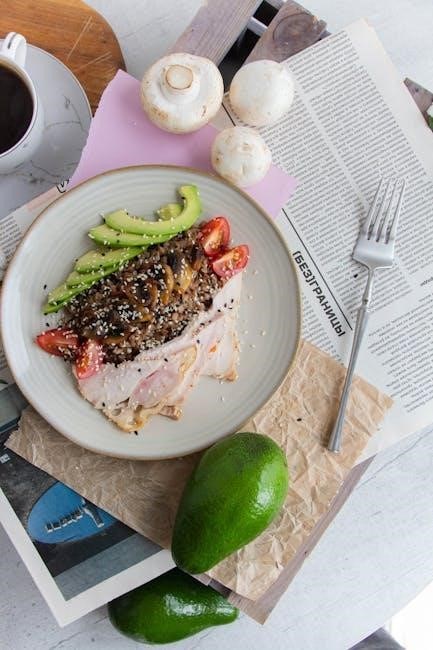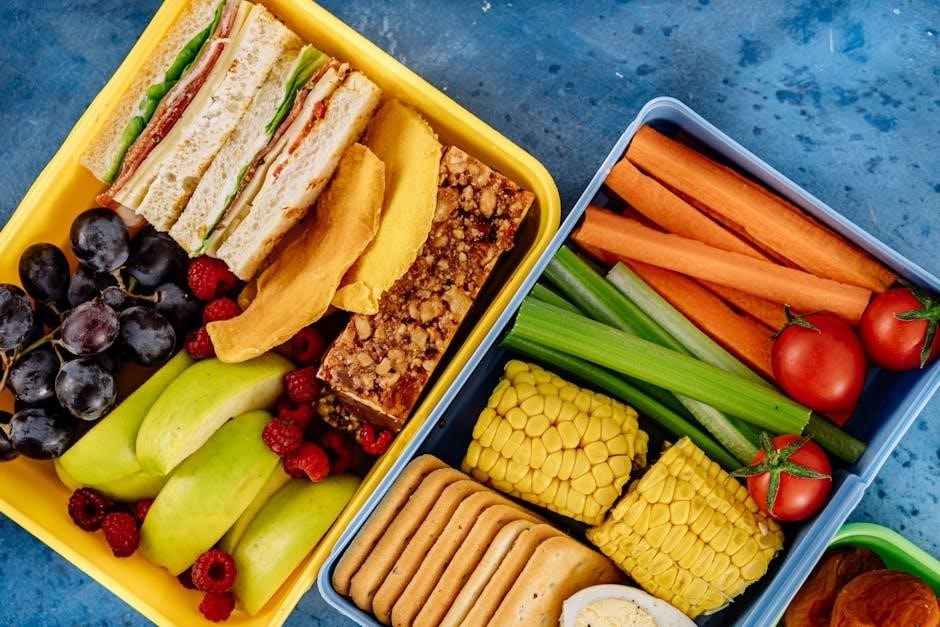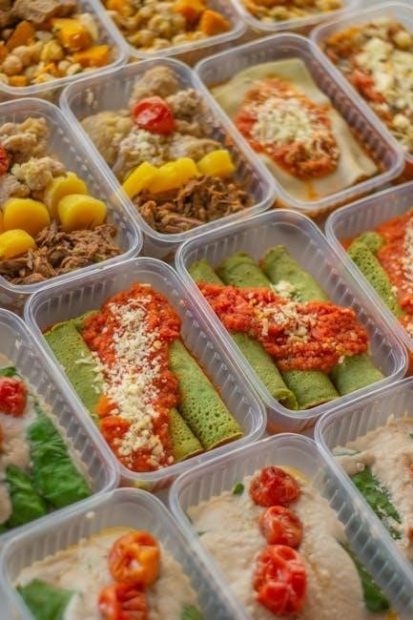A structured approach to nutrition is crucial after bariatric surgery. A printable bariatric meal plan provides a clear, organized guide, ensuring patients meet dietary goals and maintain a healthy lifestyle.
1.1 Understanding the Importance of Meal Planning After Bariatric Surgery
Meal planning is essential after bariatric surgery to ensure proper nutrition and weight loss. Without a structured plan, patients may struggle to meet dietary requirements, leading to potential deficiencies. A well-organized meal plan helps control portion sizes, balances nutrients, and avoids unhealthy choices. It also aids in tracking progress and staying compliant with post-surgery guidelines. By following a printable bariatric meal plan, individuals can maintain consistency, reduce the risk of complications, and adapt to their new dietary needs. Consistency in meal planning is key to long-term success and overall health after surgery.
1.2 Benefits of a Printable Bariatric Meal Plan
A printable bariatric meal plan offers numerous benefits, including structure and accountability. It provides a clear roadmap for daily nutrition, ensuring patients stay on track with their dietary goals. The plan is customizable, allowing individuals to tailor meals based on preferences and nutritional needs. Having a physical copy makes it easier to reference and adhere to the plan, reducing decision fatigue. It also serves as a visual reminder of the importance of proper nutrition post-surgery. By following a printable meal plan, patients can better manage portion sizes, avoid unhealthy choices, and maintain consistency in their eating habits, which is crucial for long-term success after bariatric surgery.

General Nutrition Guidelines for a Bariatric Diet
A bariatric diet focuses on high protein, low sugar, and minimal fat, emphasizing fiber-rich foods and proper hydration. Portion control and balanced meals are essential for success.
2.1 Protein Requirements and Sources
Protein is a cornerstone of a bariatric diet, essential for maintaining muscle mass and promoting healing. Patients are typically advised to consume 60-80 grams of protein daily. Sources include lean meats like chicken, turkey, or fish, as well as plant-based options such as tofu, legumes, and low-fat dairy. Portion sizes are small, so choosing high-quality, nutrient-dense proteins is crucial. A printable meal plan can help track daily intake, ensuring goals are met without exceeding stomach capacity. Avoiding low-quality proteins like processed meats is recommended to optimize nutritional benefits and support long-term weight loss and overall health.
2.2 Importance of Fiber and Vegetables
Fiber and vegetables are vital for a healthy bariatric diet, promoting digestion and preventing complications like dumping syndrome. Non-starchy vegetables such as broccoli, spinach, and cucumbers are ideal, as they are low in calories and rich in nutrients. Fiber helps maintain satiety and supports stable blood sugar levels. Incorporating a variety of colorful vegetables ensures essential vitamins and minerals. A printable meal plan can guide patients in balancing fiber intake with protein, avoiding overconsumption that may cause discomfort. Proper portion sizes and gradual introduction of vegetables are key to long-term success and overall health post-surgery.
2.3 Reducing Sugar and Fat Intake
Minimizing sugar and fat is essential for bariatric patients to achieve weight loss and maintain health. Sugary and high-fat foods can hinder progress and cause complications like dumping syndrome. A printable meal plan helps identify and avoid such foods, promoting healthier choices. Opting for natural sugars from fruits and lean proteins reduces cravings and supports balanced nutrition. Portion control and mindful eating are emphasized to ensure adherence to dietary guidelines. By focusing on whole, nutrient-dense foods, patients can effectively reduce sugar and fat intake, fostering a sustainable weight loss journey and improved overall well-being post-surgery.
2.4 Staying Hydrated: Fluid Intake Recommendations
Adequate hydration is vital for bariatric patients to support digestion, metabolism, and overall health. A printable meal plan often includes reminders to drink plenty of fluids, typically 8-10 glasses daily. Water, sugar-free herbal teas, and low-calorie broths are recommended. Fluid intake should be spaced between meals to avoid discomfort and aid digestion. Avoid carbonated and sugary beverages, which can cause bloating or dumping syndrome. Proper hydration helps prevent dehydration, enhances nutrient absorption, and supports weight loss efforts. Incorporating hydration tracking in the meal plan ensures consistency and adherence to post-surgery guidelines, promoting long-term success and well-being.
Food List for Bariatric Diets
A bariatric food list emphasizes protein-rich foods, non-starchy vegetables, and low-sugar fruits. Whole grains and lean meats are encouraged, while sugary and high-fat items are limited.
3.1 Allowed Foods: Protein, Vegetables, and Fruits
Protein-rich foods like lean meats, fish, eggs, tofu, and legumes are essential for muscle maintenance and satiety. Non-starchy vegetables such as spinach, broccoli, and cauliflower are highly recommended due to their low calorie and high fiber content. Fruits should be chosen wisely, focusing on low-sugar options like berries, citrus fruits, and apples. These foods provide essential nutrients, vitamins, and minerals while supporting weight loss and overall health. Portion control and variety are key to ensuring a balanced diet. Incorporating these foods into a printable meal plan helps bariatric patients stay on track and achieve their dietary goals effectively.
3.2 Restricted Foods: Sugary and High-Fat Items
Sugary and high-fat foods are typically restricted in a bariatric diet due to their high calorie content and potential to hinder weight loss. These include candy, pastries, fried foods, and processed snacks. Consuming such items can lead to weight regain and negatively impact overall health. Additionally, sugary foods may trigger dumping syndrome in some patients. It’s important to avoid or significantly limit these foods to maintain progress and adhere to dietary guidelines. A printable meal plan can help identify and avoid these restricted items, promoting healthier choices and long-term success in bariatric nutrition.
3.3 Food Portion Sizes and Meal Frequency
Portion control is essential for bariatric patients to manage weight loss and adaptation to smaller stomach capacity. Initially, portions are limited to 1/2 to 1 cup per meal, gradually increasing as tolerance improves. Meals should be spaced every 3-4 hours, with 3 main meals and 1-2 snacks daily. Prioritizing high-protein foods helps maintain muscle mass and satisfaction. A printable meal plan can guide appropriate portion sizes and meal timing, ensuring balanced nutrition and preventing overeating. Consistency in portion control and meal frequency supports long-term success and avoids discomfort or weight regain.
Meal Preparation and Planning Tips
Effective meal preparation and planning are crucial for bariatric success. Schedule meals, shop for ingredients, and organize portions in advance. Use a printable meal plan to stay organized, ensuring balanced nutrition and avoiding last-minute decisions that may lead to unhealthy choices. This structured approach helps maintain consistency and supports long-term weight loss goals.
4.1 How to Plan Meals for Weight Loss
Planning meals for weight loss after bariatric surgery involves setting clear calorie and protein goals. Start by identifying high-protein, low-sugar foods and incorporating them into your diet. Focus on balanced meals with protein, vegetables, and small portions of whole grains. Avoid sugary and high-fat items, as they can hinder progress. Use a printable bariatric meal plan PDF to organize your daily intake, ensuring portion control and meal frequency are maintained; Schedule meals every 3-4 hours to keep metabolism active and prevent overeating. Track your progress and adjust as needed to stay on course with your weight loss objectives.
4.2 Creating a Balanced Meal Plate
Creating a balanced meal plate after bariatric surgery is essential for weight loss and overall health. Prioritize protein-rich foods like lean meats, fish, or plant-based options, taking up half of your plate. Fill the remaining space with non-starchy vegetables and a small portion of fruits. Avoid high-sugar and high-fat items to maintain progress. Use a printable bariatric meal plan PDF to guide portion sizes and ensure variety. Incorporate healthy fats like avocado or nuts in moderation. Stay hydrated with sugar-free beverages, and avoid consuming liquids during meals to prevent discomfort. This structured approach helps achieve nutritional balance and supports long-term weight management goals effectively.
4.3 Tips for Making the Perfect Meal Replacement Shake
Creating a nutritious meal replacement shake is essential for bariatric patients, especially during early stages or when solid foods are challenging. Start with a high-protein, low-sugar base such as unsweetened almond milk or Greek yogurt. Add 1-2 scoops of bariatric-specific protein powder (20-30 grams of protein per serving). Incorporate 1/2 cup of frozen berries for fiber and antioxidants. Include a tablespoon of healthy fats like peanut butter or chia seeds for satiety. Avoid sugary additives and opt for natural sweeteners like stevia if needed. Blend well and consume slowly. Use a printable bariatric meal plan PDF to track your shakes and ensure they align with your dietary goals. Keep portions small to prevent discomfort.
4.4 Whole Food Meal Ideas for Bariatric Patients
Whole foods are essential for a balanced bariatric diet, focusing on protein, vegetables, and fruits. Breakfast ideas include scrambled eggs with spinach or Greek yogurt with berries. Lunch options might be grilled chicken with roasted vegetables or a small portion of lentils with a side salad. Dinner could feature baked fish, quinoa, and steamed green beans. Snacks like hard-boiled eggs or cottage cheese are ideal. Portion control is key, with meals sized to fit individual needs. A printable bariatric meal plan PDF can help organize these ideas, ensuring variety and adherence to dietary guidelines for long-term success.

Transitioning Through Diet Stages After Surgery
Post-bariatric surgery, patients progress through stages: clear liquids, full liquids, soft foods, and solids. Each stage introduces new textures, supporting healing and adaptation to eating habits.
5.1 Stage 1: Clear Liquids and Sugar-Free Options
Immediately post-surgery, patients begin with clear liquids to minimize strain on the stomach. This stage includes water, clear broths, sugar-free electrolyte drinks, and unsweetened herbal teas. Avoiding sugar prevents complications like dumping syndrome. Small, frequent sips are recommended to manage tolerance. A printable meal plan can help track intake, ensuring adherence to this critical phase. It’s essential to choose sugar-free options to promote healing and stabilize blood sugar levels. This stage typically lasts 1-2 weeks, gradually transitioning to thicker liquids as the body adjusts.
5.2 Stage 2: Full Liquids and Soft Foods
After clear liquids, patients progress to full liquids and soft foods, typically 1-2 weeks post-surgery. This stage includes items like scrambled eggs, soft cheeses, and pureed vegetables. Foods must be smooth in texture to avoid irritation. Portion sizes remain small, gradually increasing as tolerance improves. A printable meal plan can outline allowable foods, such as low-fat yogurt and thin soups, ensuring variety and nutrition. This phase introduces protein sources like tofu and lean meats in soft forms. Staying hydrated with sugar-free fluids remains crucial. The goal is to ease the transition to solid foods while maintaining nutritional balance and avoiding discomfort.
Stage 3 marks the transition to solid foods, typically 4-6 weeks post-surgery. Patients can gradually incorporate soft, easily chewable foods like tender meats, soft-cooked vegetables, and small portions of whole grains. Eggs, tofu, and low-fat dairy products are also introduced. It’s crucial to chew thoroughly to avoid discomfort or complications. A printable meal plan can help guide this phase, ensuring balanced nutrition and portion control. Foods should still be small in quantity, increasing slowly as tolerance improves. This stage focuses on reintroducing variety while maintaining a focus on protein-rich and nutrient-dense options to support healing and weight loss goals effectively.
5.4 Long-Term Diet Maintenance
Long-term diet maintenance focuses on sustaining a healthy, balanced diet to ensure continued weight loss and overall well-being. Patients are encouraged to stick to small, frequent meals rich in protein and nutrients. A printable bariatric meal plan can serve as a valuable tool, helping individuals stay organized and compliant with dietary guidelines. Emphasis remains on avoiding high-sugar and high-fat foods while incorporating whole, nutrient-dense options. Regular hydration and mindful eating are also critical. Over time, patients adapt to a sustainable eating pattern that supports their long-term health goals, making the printable meal plan a lasting resource for maintaining a healthy lifestyle post-surgery.

Sample Daily and Weekly Meal Plans
A printable bariatric meal plan offers a structured 1000-calorie daily schedule, including breakfast, lunch, dinner, and snacks. A 7-day template ensures variety and customization for individual needs.
6.1 Sample Breakfast, Lunch, Dinner, and Snack Ideas
A printable bariatric meal plan provides structured ideas for each meal. Breakfast options include scrambled eggs with avocado or Greek yogurt with chia seeds. Lunch ideas feature lean proteins like chicken or lentils paired with vegetables. Dinner suggestions include grilled meats or fish with a side of steamed veggies. Snacks like nut butter with apple slices or a small portion of cottage cheese are recommended. These meals are designed to be nutrient-dense, low in sugar, and portion-controlled, ensuring adherence to bariatric dietary guidelines. The plan emphasizes protein-rich foods, fiber, and hydration to support weight loss and overall health.
6.2 7-Day Meal Plan Template for Bariatric Patients
A 7-day meal plan template offers a structured approach to daily nutrition, ensuring variety and adherence to bariatric dietary guidelines. Each day includes balanced meals with protein, vegetables, and healthy fats, while avoiding sugary and high-fat items. The template allows customization based on individual preferences and dietary needs. Breakfast options might include scrambled eggs or Greek yogurt, while lunches feature lean proteins like chicken or fish. Dinners focus on portion-controlled meals with steamed vegetables. Snacks are designed to keep energy levels stable, such as nut butter with apple slices. This template helps patients stay organized and motivated, promoting long-term weight loss and health maintenance.
6.3 Adjusting the Plan Based on Individual Needs
Every patient’s journey is unique, and a printable bariatric meal plan should be tailored to individual needs. Adjustments may include modifying portion sizes, protein intake, or calorie goals based on progress and preferences. For example, some may require higher protein or lower fat intake, while others might need to accommodate food allergies or intolerances. Patients can swap out ingredients or interchange meal ideas to keep the plan engaging. Regular consultations with a dietitian ensure the plan remains aligned with health goals. Flexibility is key to long-term success, allowing patients to adapt the meal plan as they progress through different stages of their bariatric journey.

Common Questions and Concerns
Common concerns include managing protein intake, staying hydrated, and avoiding high-sugar foods. Patients often ask about portion sizes and the role of supplements in their diet.
7.1 What to Eat After Bariatric Surgery
Post-bariatric surgery, focus on nutrient-dense foods like lean proteins, vegetables, and low-sugar fruits. Start with clear liquids, progressing to soft foods, and eventually solid meals. Avoid high-sugar and fatty items to prevent complications. Protein intake is essential for healing and muscle retention. Include portions of fiber-rich foods to aid digestion. Hydration is critical, with fluids consumed between meals. portion sizes are small, typically 1/2 to 1 cup per meal. A structured meal plan ensures adherence to dietary guidelines, promoting weight loss and overall health. Consult a healthcare provider for personalized recommendations.
7.2 Managing Dumping Syndrome
Dumping syndrome occurs when food, especially sugar-rich or high-fat items, moves too quickly from the stomach to the small intestine. Symptoms include nausea, diarrhea, and abdominal pain. To manage this, eat smaller, balanced meals and avoid sugary or fatty foods. Incorporate protein-rich foods and fiber to slow digestion. Drink fluids between meals, not during, to prevent overwhelming the stomach. Chewing thoroughly and avoiding carbonated beverages can also help. A printable bariatric meal plan can guide food choices, ensuring meals are low in triggers and high in nutrients. This structured approach reduces the risk of dumping syndrome and supports long-term digestive health.
7.3 How to Avoid Weight Regain
Avoiding weight regain after bariatric surgery requires consistent effort and adherence to healthy habits. Stick to your printable bariatric meal plan, focusing on protein-rich, nutrient-dense foods, and avoid unhealthy snacks. Practice portion control and eat slowly to prevent overeating. Incorporate regular physical activity, such as walking or strength training, to maintain muscle mass and metabolism. Stay hydrated and limit sugary or high-calorie beverages. Track your progress with a food diary and consult your healthcare team for adjustments. Avoid skipping meals or relying on processed foods, as these can hinder long-term success. By following these guidelines, you can maintain your weight loss and enjoy a healthier lifestyle.
7.4 Role of Supplements in Bariatric Diets
Supplements play a vital role in ensuring proper nutrition after bariatric surgery. Due to reduced stomach capacity and altered nutrient absorption, patients often require multivitamins, vitamin B12, calcium, and iron. These supplements help prevent deficiencies and support overall health. A printable bariatric meal plan PDF often includes recommendations for daily supplements to complement meals. It’s essential to follow your healthcare provider’s guidelines, as needs may vary. Regular blood tests can help monitor nutrient levels and adjust supplementation accordingly. Remember, supplements are not a replacement for a balanced diet but a necessary addition to maintain long-term health and energy levels post-surgery.
Tracking Progress and Staying Compliant
Tracking progress through food diaries and regular check-ins ensures long-term success. Compliance with meal plans and hydration goals supports overall health and weight loss after bariatric surgery.
8.1 Importance of Food Diaries and Tracking
Keeping a food diary is a powerful tool for monitoring progress and staying compliant with a bariatric meal plan. By recording daily food intake, patients can identify patterns, ensure portion control, and maintain accountability. Tracking helps in assessing protein intake, hydration levels, and overall adherence to dietary guidelines. Regular monitoring also aids in identifying potential challenges, such as nutrient deficiencies or trigger foods. Sharing these records with healthcare providers allows for personalized adjustments and support. Printable meal plans can be paired with food diaries to enhance organization and consistency, promoting long-term success and healthier eating habits post-surgery.
8.2 Tips for Long-Term Success
Consistency is key to achieving long-term success with a bariatric meal plan. Staying committed to balanced nutrition, portion control, and regular hydration helps maintain weight loss and overall health. Incorporating protein-rich foods, vegetables, and whole grains into meals supports satiety and nutrient needs. Avoiding high-sugar and high-fat foods is crucial for preventing weight regain. Regular physical activity and mindful eating habits also play a significant role in sustaining results. Tracking progress through food diaries or mobile apps can enhance accountability and motivation. Seeking support from healthcare providers or online communities ensures ongoing guidance and encouragement for a healthier lifestyle.
8.3 How to Stay Motivated on the Bariatric Journey
Maintaining motivation is essential for long-term success after bariatric surgery. Celebrating small milestones, like reaching a new weight loss goal, can boost confidence and encourage persistence. Setting realistic expectations and focusing on gradual progress helps sustain determination. Engaging with support groups or online communities provides emotional support and shared experiences, reducing feelings of isolation. Printing and using a structured meal plan can serve as a visual reminder of commitments, helping to stay on track. Remembering the reasons behind choosing bariatric surgery, such as improved health or increased energy, can reignite motivation during challenging times. Consistency and self-compassion are key to overcoming setbacks and achieving lasting results.

Additional Resources and Tools
Utilize printable PDF templates for meal planning, explore recommended cookbooks, and join online communities for ongoing support and guidance tailored to bariatric patients’ needs and preferences.
9.1 Printable PDF Templates for Meal Planning
Printable PDF templates are essential tools for organizing and tracking meals post-bariatric surgery. These templates provide a structured format, allowing patients to plan meals in advance, ensuring adherence to dietary guidelines. Many templates are customizable to suit individual needs, offering spaces to note breakfast, lunch, dinner, and snacks. They often include sections for tracking protein intake, fiber consumption, and hydration levels. Some templates also feature areas for recording supplements, meal portion sizes, and daily goals. By using these templates, patients can maintain accountability and stay on track with their nutrition plan. Downloadable and easy to use, they are a valuable resource for long-term success and healthy eating habits.
9.2 Recommended Cookbooks for Bariatric Patients
Recommended cookbooks for bariatric patients offer tailored recipes and guidance for post-surgery nutrition. Titles like The Complete Bariatric Cookbook and Meal Plan provide high-protein, low-sugar meal ideas, ensuring meals are nutritious and flavorful. These cookbooks often include recipes suitable for different diet stages, from pureed foods to solid meals. They emphasize portion control, balanced nutrition, and creative meal ideas to prevent boredom. Many feature easy-to-follow instructions and emphasize whole, nutrient-dense foods. These resources are invaluable for patients seeking structure and variety in their meal planning journey, helping them stay compliant with dietary guidelines while enjoying satisfying meals.
9.3 Online Communities and Support Groups
Online communities and support groups are invaluable for bariatric patients, offering shared experiences, advice, and motivation. Platforms like Facebook groups, forums, and specialized websites connect individuals undergoing similar journeys. These communities often share printable meal plans, recipes, and tips for navigating diet stages. Many groups are moderated by healthcare professionals, ensuring accurate and helpful guidance. Patients can exchange ideas, ask questions, and celebrate milestones, fostering a sense of belonging and accountability. These resources are particularly useful for staying motivated and inspired, helping individuals adhere to their meal plans and achieve long-term success. Active participation in these groups can significantly enhance the bariatric journey.
